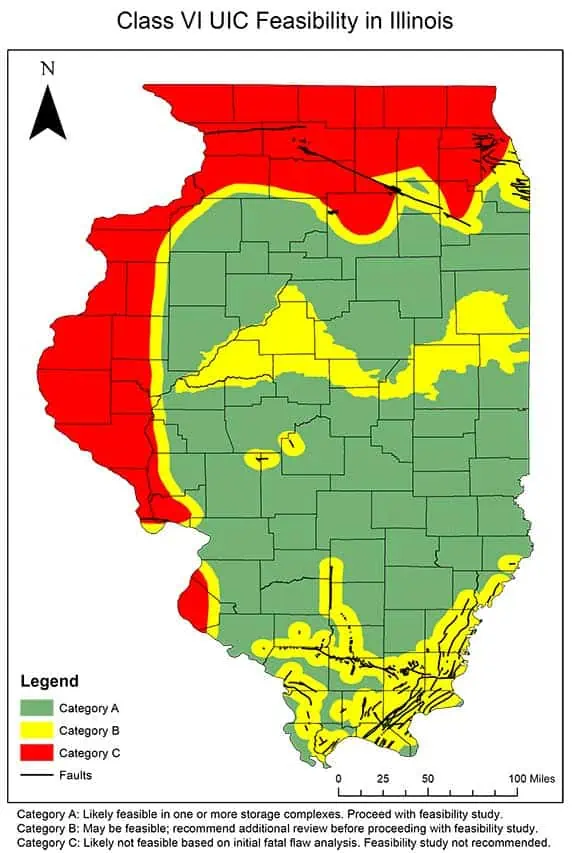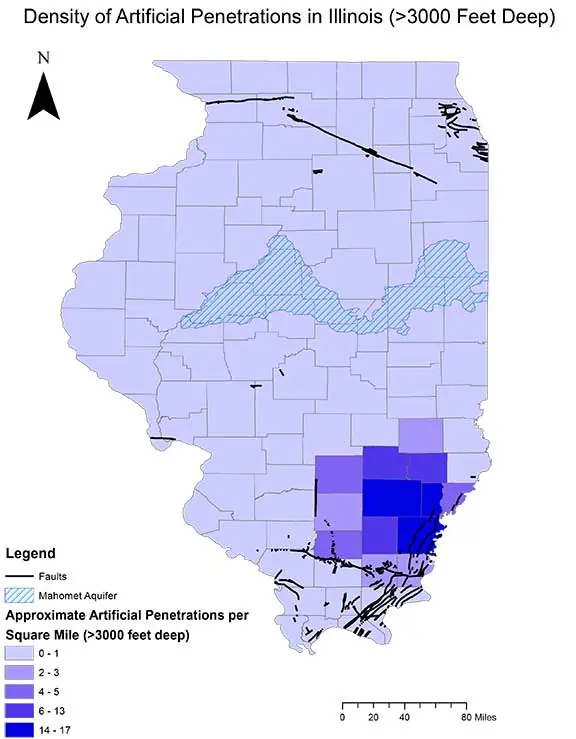

Climate Change and Geologic Sequestration
With climate change becoming the center of attention globally and pending mandates to reduce carbon footprints, our authors provide detailed insight into why Carbon Capture and Storage (CCS) may be a mitigation strategy. Our focus is on Illinois to provide you with details on state-specific feasibility.
The United States Department of Energy (USDOE) is leading the CarbonSAFE program across the U.S. to conduct research for the development of technologies for mitigating greenhouse gas emissions to the atmosphere. The state of Illinois hosts a portion of the program called CarbonSAFE – Illinois.
CCS applies to facilities that are point-source emitters of carbon dioxide (CO2), including ethanol plants, various manufacturing facilities, and fossil-fuel power plants. Through the Inflation Reduction Act (IRA) of 2022, facilities that capture and sequester CO2 can qualify for federal tax incentives (45Q). These facilities can reduce net carbon emissions by employing CCS, which prevents CO2 emissions from entering the atmosphere, promotes them as environmental stewards, and helps foster economic growth.
Geologic sequestration of CO2 (GS) requires a Class VI injection well permit. Under the United States Environmental Protection Agency’s (USEPA) Underground Injection Control (UIC) Program, a Class VI injection well injects supercritical CO2 (i.e., highly compressible fluid without distinct solid and gas phases) into deep geologic formation(s). These sequestration wells’ regulations fall under the Safe Drinking Water Act (SDWA). The Illinois Environmental Protection Agency (IEPA) oversees a well-developed state UIC program and holds primacy for regulating UIC well classes I-V. IEPA does not currently hold primacy for Class VI UIC wells; primacy resides with the USEPA Region 5.
Suitability of Geologic Sequestration in the Illinois Basin
In Illinois, Class I and Class II UIC wells demonstrate the utility of UIC for permanent waste disposal or enhanced oil recovery (EOR). The well-studied geologic characteristics of the Illinois Basin drive successful Class I and II UIC wells and hydrocarbon production. As geologic units within the basin proved to be successful hydrocarbon reservoirs, the research focuses on their utility for permanent CO2 sequestration and injection of CO2 for EOR. The only permitted, and active Class VI UIC wells in the U.S. are in Macon County, Illinois. These wells are part of a CarbonSAFE – Illinois project, the Illinois Basin – Decatur Project (IBDP). According to the National Energy Technology Laboratory (NETL, 2017), this successful project is the only completed large-scale injection of CO2 into a saline formation. The project is paving the way for future commercial-scale CCS.
While the Illinois Basin is generally considered feasible for CCS, we cannot assume that any location within the basin will be suitable to host Class VI UIC. GS is not applicable in all locations, and feasibility depends on several geologic conditions. We must investigate the appropriate subsurface geology to minimize project risk and comply with SDWA requirements. Geologic feasibility must be assessed as part of initial project scoping to determine if a location is suitable for underground CO2 storage. The permitting process for Class VI UIC is long and requires large capital expenditures upfront during the pre-operational phase. Fortunately, careful scoping early in the process regarding geologic suitability will minimize uncertainty, project risk, and long-term project costs. This maximizes the likelihood of success in the permitting process.
Mapping Tools Help Determine Where Class VI UIC Will Succeed

The geologic suitability map indicates categorically whether:
Should category A or B apply to a potential project, SCS can assess the presence and density of existing artificial penetrations to give potential clients a sense of their project’s complexity.
The geologic suitability map considers geologic conditions that must be present for underground storage of supercritical CO2 and other conditions that may lead to challenges, including:
In addition to general geologic suitability, SCS created a map showing the density of deep artificial penetrations (>3,000 feet) in Illinois. Due to oil and gas production, artificial penetrations (wells) are common across Illinois, particularly in the state’s southern half. Improperly plugged or abandoned artificial penetrations can act as conduits for injection fluids, so it is essential to be aware of these penetrations and their depths when choosing an injection location. We obtained the data from the Illinois State Geological Survey’s (ISGS) Illinois Oil and Gas Resources ArcGIS online application. Each penetration has unique attributes assigned in the mapping tool that allows for assessing parameters such as depth, current status, and ownership. The findings give an additional sensitivity to be aware of should the prospective Class VI UIC project proceed to the detailed feasibility study phase.

Additionally, SCS can plot hypothetical scenarios within the mapping tool and generate a corresponding list and map of penetrations falling within each hypothetical AOR. Due to the available deep subsurface geologic data, a high density of artificial penetrations may be beneficial. Conversely, this could be problematic if these wells penetrate the confining or injection zone(s) and are improperly plugged or abandoned, resulting in a potential vertical pathway for injected CO2 to migrate into the protected USDWs.
Suppose your facility is in Category B. Before proceeding with a feasibility study, there may be additional challenges and uncertainties, so we use the artificial penetrations map to develop data that address these challenges. SCS works with you to determine challenges and cost-effective ways to overcome them. We discuss alternatives if the additional assessment uncovers considerable permitting challenges or project risks. Then, we move on to a detailed feasibility study after minimizing risks.
If your facility is in Category C, on-site Class VI UIC is most likely not feasible due to the geologic conditions present. SCS does not recommend proceeding with a feasibility study for on-site storage but works with you to determine alternatives.
We aim to kickstart your thinking about the Class VI UIC permitting process and what challenges or complexities may exist.
Contact Kacey, Charles, or to discuss your projects and goals. We will work with you to design solutions suitable for your company to remove greenhouse gases from the atmosphere and obtain the 45Q tax credits.
Meet the Authors:
Kacey Garber, M.S., Project Professional ()
Charles Hostetler, Ph.D., Senior Project Advisor ()
Additional Resources: